December 4, 2003
Joysticks
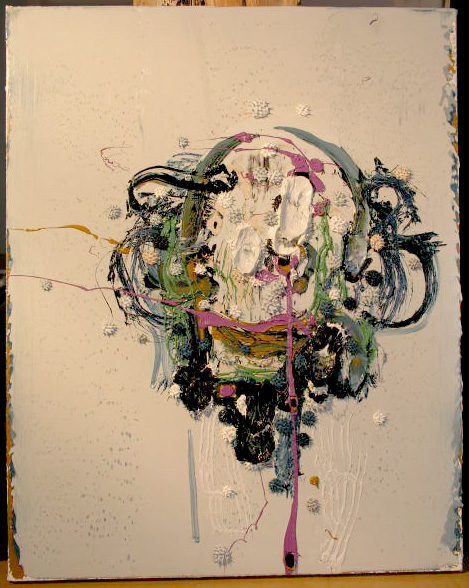
Right about now, I'm militating against the original objectives. Thoughts like this arise: "...and now for something completely different."
I use the image of a tacking sailboat to describe this. For example, one thought is to take the tissue of marks to the edges, as opposed to the schema of the portrait (or still life, even) that organizes the clot of marks against a monochrome field. The words "...as opposed to..." are what I want to highlight here, because even if I take the next three panels into an antithetical direction, I'm stil thinking about how to get closer to what promise I see in the portrait schema.
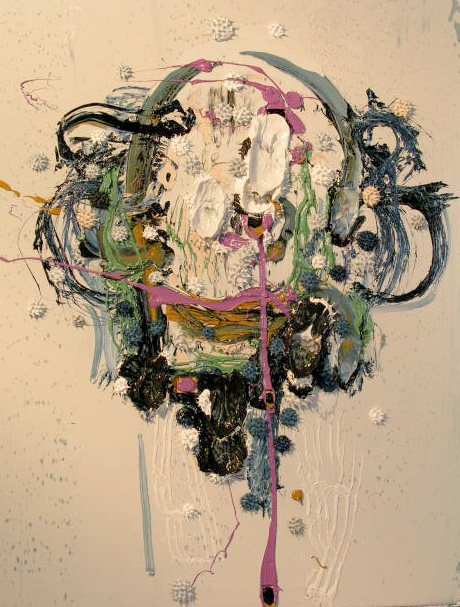
Over the summer, I painted the series of 44"x48" panels, each seeking alternate directions. It wasn't this or that, but this or that, then this and this and that. I didn't forsake a direction because I returned to it later. I remember an amphorism somewhere that maintained that consciousness arises from contrast or an awareness of opposites.
It is the tension-between that's interesting for me and not necessarily the fufillment of any particlular singular objective. What I'm trying to get at here is a kind of incommensurability, a persistent lack, the difference between a thought and a physical manifestation that will always remain an attempt.
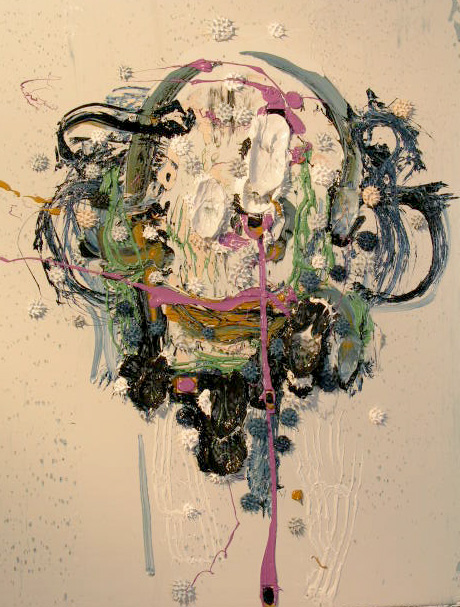
This is something I tried to communicate to my students when I taught architecture. I wanted them to understand that when they imagine a project, they idealize it to a large degree, that it seems whole and complete to their minds when in fact it is a mere suggestion when compared to its' physical manifestation.
For example: Imagine a table. Each of us can hold an image of a table in our minds. Then the questions come. What is it made of and how will this affest the connections? A table has a surface and a way to keep it up, legs. How do the legs attach to the surface? Directly? By a skirt? How will it be stabile? Will you use triangulation to make the structure rigid, or will you rely on connections that resist rotation?
Did you hold these thoughts all in the beginning when you first imaged the table? Haven't we all engaged a project, having to problem solve each of these kind of issues, making things much more difficult than you originally imagined? Initially, the table floats in our minds and we are blind to the cloud it floats within. Then these questions sharpen the mental image, adding facets of detail. The table gets complex.
Hubris persists, and we fall back to thinking that an evolved thought is complete and equal to reality. But because being human is to fall prey to arrogant pride, I vote for the reality check of physical substance. Thoughts tethered to materiality doesn't constrain, it makes both strong. It gives the dispositoin of matter a cause and it gives intentions meat.
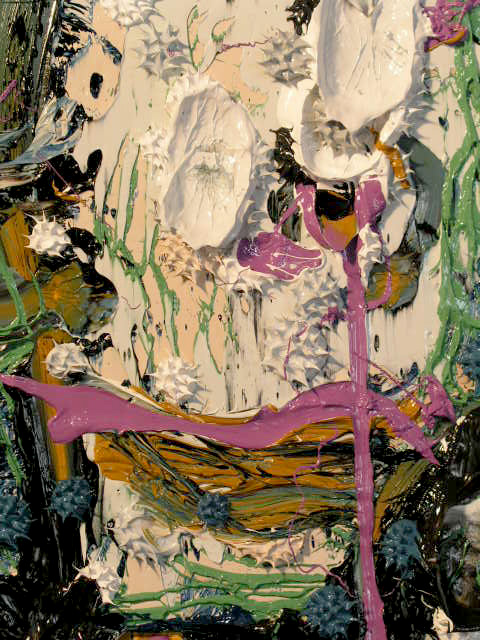
The point here is not only that there is a difference between imagination and reality, not only that imagination is gauzy and fuzzy, not only that our imagination has an uncanny ability to fill in the gaps that makes us think we know more than we really do.... but that this can be good, interesting, worth exploring.
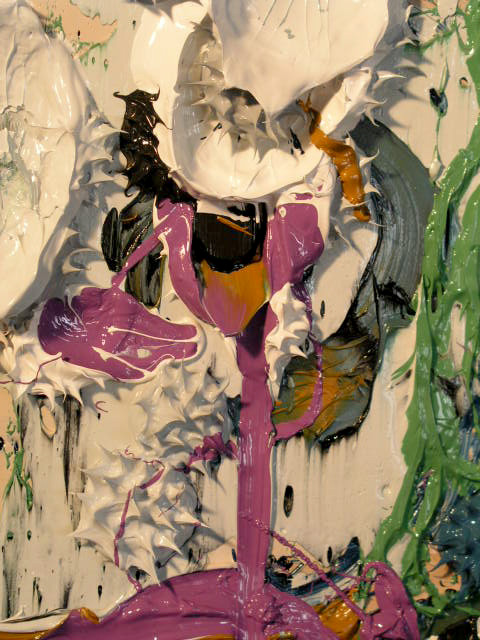
This slip betwixt the cup of mind and the lip of physical reality is fascinating to me. In these paintings, I'm pushing the build up of marks over the top in that those flower like whallops smash the spiny monads and flip them into petals of paint. Speed matters more than before, and there's an orchestration that is required to make this happen. While it is the bellyflops or whallops that I'm looking for, they require not only a complex bed of painted marks, but that this bed must have a lack... because I'm editing by cutting out or covering, and the whallops are covering, strengthening weaker spots in the painting.
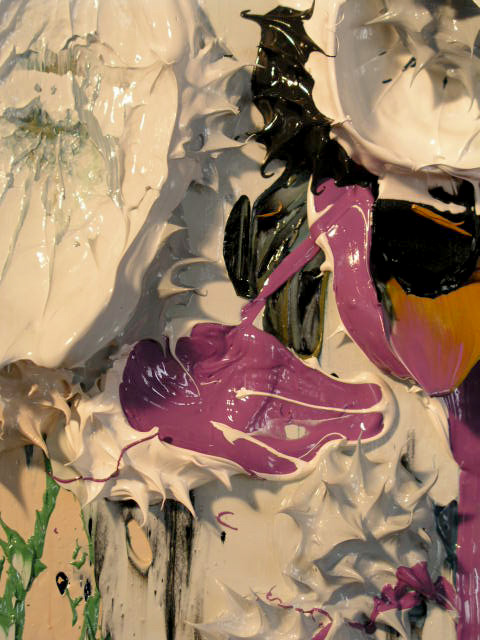
For example, if you can see the purple impact into the white spiny monad above. I used to deliver this kind of mark by an overhead throw of paint from a loaded pallete knife. But since this method makes a linear form, and i wanted a freaky one, I improvised a different way to make this happen. I took a large brush that was spent, the bristles wasted. I removed the bristles and metal ferrule and I had a sturdy wooden instrument that was fat and shaped at the tip. I dip it into a wad of paint and knock it against the end of another brush handle, standing over the painting surface whilst it was horizontal. This delivers a freaky line and incidental sinews of paint.
One incident was this impact, a blob of purple careening into the monad, you can see the tendril of purple connecting it to the main mass. From the direction of the ejecta, you can see the trajectory of the impact distorting the original spiny sphere, leaving a thin ring around the deformed projectile. Two spikes are flipped back into the crater, you can imagine the form elongating to the right as the spikes rotate into the flattening projectile, then stretching and imprinting itself into the crater. You can see the hole in the center of the ejecta ring as the paint thins into a filmy membrane so much that a void appears in the middle. You can se the lead of the ejecta as it bulldoses into the bed of white, pushing up a dune in front of it.
What's the point of this description? This is the kind of feature I don't want to cover up. And the original intent was that I had to use a method of covering to deliver the coup de grace of the flower whallops... and yet this happens.
What this means I guess is while there are two kinds of marks: careful and reckless.... maybe I should a litle more reckless in the beginning? That's a bit hard to do since every mark I make has aspects I like and aspects I don't. In this more-or-less relation, i'm not sure how to make more than less, or visa versa, with an undesireable artifice to it.
Posted by Dennis at December 4, 2003 7:50 AM
Leave a comment